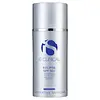What's inside
What's inside
 Key Ingredients
Key Ingredients

 Benefits
Benefits

 Concerns
Concerns

 Ingredients Side-by-side
Ingredients Side-by-side

Water
Skin ConditioningCaprylic/Capric Triglyceride
MaskingDimethicone
EmollientStearyl Alcohol
EmollientTribehenin
EmollientGlycerin
HumectantSteareth-20
CleansingSteareth-2
EmulsifyingHydrogenated Coco-Glycerides
EmollientPhenoxyethanol
PreservativeSucrose Dilaurate
EmollientOctyldodecanol
EmollientCyclopentasiloxane
EmollientXanthan Gum
EmulsifyingCaprylyl Glycol
EmollientDimethiconol
EmollientHexylene Glycol
EmulsifyingEthylhexylglycerin
Skin ConditioningPolysorbate 20
EmulsifyingTocopheryl Acetate
AntioxidantHelianthus Annuus Seed Wax
Skin ConditioningPisum Sativum Extract
Skin ConditioningSantalum Album Wood Extract
PerfumingGlycyrrhiza Glabra Root Extract
BleachingChamomilla Recutita Flower Extract
MaskingBerberis Vulgaris Bark Extract
Skin ConditioningP-Anisic Acid
MaskingSorbic Acid
PreservativeAscorbyl Palmitate
AntioxidantSorbitol
HumectantVaccinium Myrtillus Fruit/Leaf Extract
AstringentSodium Benzoate
MaskingPotassium Sorbate
PreservativeCitric Acid
BufferingSuperoxide Dismutase
AntioxidantCalcium Ascorbate
AntioxidantSaccharum Officinarum Extract
MoisturisingCitrus Limon Fruit Extract
MaskingCitrus Aurantium Dulcis Fruit Extract
MaskingAcer Saccharum Extract
Skin ConditioningWater, Caprylic/Capric Triglyceride, Dimethicone, Stearyl Alcohol, Tribehenin, Glycerin, Steareth-20, Steareth-2, Hydrogenated Coco-Glycerides, Phenoxyethanol, Sucrose Dilaurate, Octyldodecanol, Cyclopentasiloxane, Xanthan Gum, Caprylyl Glycol, Dimethiconol, Hexylene Glycol, Ethylhexylglycerin, Polysorbate 20, Tocopheryl Acetate, Helianthus Annuus Seed Wax, Pisum Sativum Extract, Santalum Album Wood Extract, Glycyrrhiza Glabra Root Extract, Chamomilla Recutita Flower Extract, Berberis Vulgaris Bark Extract, P-Anisic Acid, Sorbic Acid, Ascorbyl Palmitate, Sorbitol, Vaccinium Myrtillus Fruit/Leaf Extract, Sodium Benzoate, Potassium Sorbate, Citric Acid, Superoxide Dismutase, Calcium Ascorbate, Saccharum Officinarum Extract, Citrus Limon Fruit Extract, Citrus Aurantium Dulcis Fruit Extract, Acer Saccharum Extract
Water
Skin ConditioningTitanium Dioxide
Cosmetic ColorantZinc Oxide
Cosmetic ColorantC12-15 Alkyl Benzoate
AntimicrobialCaprylic/Capric Triglyceride
MaskingButylene Glycol
HumectantOctyldodecyl Neopentanoate
EmollientCetearyl Glucoside
EmulsifyingCetearyl Alcohol
EmollientGlyceryl Stearate
EmollientPEG-100 Stearate
Polyhydroxystearic Acid
EmulsifyingAlumina
AbrasiveMethicone
EmollientTriethoxycaprylylsilane
Tocopherol
AntioxidantVp/Eicosene Copolymer
Styrene/Acrylates Copolymer
Sorbitan Laurate
EmulsifyingTocopheryl Acetate
AntioxidantXanthan Gum
Emulsifying1,2-Hexanediol
Skin ConditioningCaprylyl Glycol
EmollientDisodium EDTA
CI 77491
Cosmetic ColorantCI 77492
Cosmetic ColorantCI 77499
Cosmetic ColorantWater, Titanium Dioxide, Zinc Oxide, C12-15 Alkyl Benzoate, Caprylic/Capric Triglyceride, Butylene Glycol, Octyldodecyl Neopentanoate, Cetearyl Glucoside, Cetearyl Alcohol, Glyceryl Stearate, PEG-100 Stearate, Polyhydroxystearic Acid, Alumina, Methicone, Triethoxycaprylylsilane, Tocopherol, Vp/Eicosene Copolymer, Styrene/Acrylates Copolymer, Sorbitan Laurate, Tocopheryl Acetate, Xanthan Gum, 1,2-Hexanediol, Caprylyl Glycol, Disodium EDTA, CI 77491, CI 77492, CI 77499
 Reviews
Reviews

Ingredients Explained
These ingredients are found in both products.
Ingredients higher up in an ingredient list are typically present in a larger amount.
This ingredient is an emollient, solvent, and texture enhancer. It is considered a skin-softener by helping the skin prevent moisture loss.
It helps thicken a product's formula and makes it easier to spread by dissolving clumping compounds.
Caprylic Triglyceride is made by combining glycerin with coconut oil, forming a clear liquid.
While there is an assumption Caprylic Triglyceride can clog pores due to it being derived from coconut oil, there is no research supporting this.
Learn more about Caprylic/Capric TriglycerideCaprylyl Glycol is a humectant and emollient, meaning it attracts and preserves moisture.
It is a common ingredient in many products, especially those designed to hydrate skin. The primary benefits are retaining moisture, skin softening, and promoting a healthy skin barrier.
Though Caprylyl Glycol is an alcohol derived from fatty acids, it is not the kind that can dry out skin.
This ingredient is also used as a preservative to extend the life of products. It has slight antimicrobial properties.
Learn more about Caprylyl GlycolTocopheryl Acetate is AKA Vitamin E. It is an antioxidant and protects your skin from free radicals. Free radicals damage the skin by breaking down collagen.
One study found using Tocopheryl Acetate with Vitamin C decreased the number of sunburned cells.
Tocopheryl Acetate is commonly found in both skincare and dietary supplements.
Learn more about Tocopheryl AcetateWater. It's the most common cosmetic ingredient of all. You'll usually see it at the top of ingredient lists, meaning that it makes up the largest part of the product.
So why is it so popular? Water most often acts as a solvent - this means that it helps dissolve other ingredients into the formulation.
You'll also recognize water as that liquid we all need to stay alive. If you see this, drink a glass of water. Stay hydrated!
Learn more about WaterXanthan gum is used as a stabilizer and thickener within cosmetic products. It helps give products a sticky, thick feeling - preventing them from being too runny.
On the technical side of things, xanthan gum is a polysaccharide - a combination consisting of multiple sugar molecules bonded together.
Xanthan gum is a pretty common and great ingredient. It is a natural, non-toxic, non-irritating ingredient that is also commonly used in food products.
Learn more about Xanthan Gum